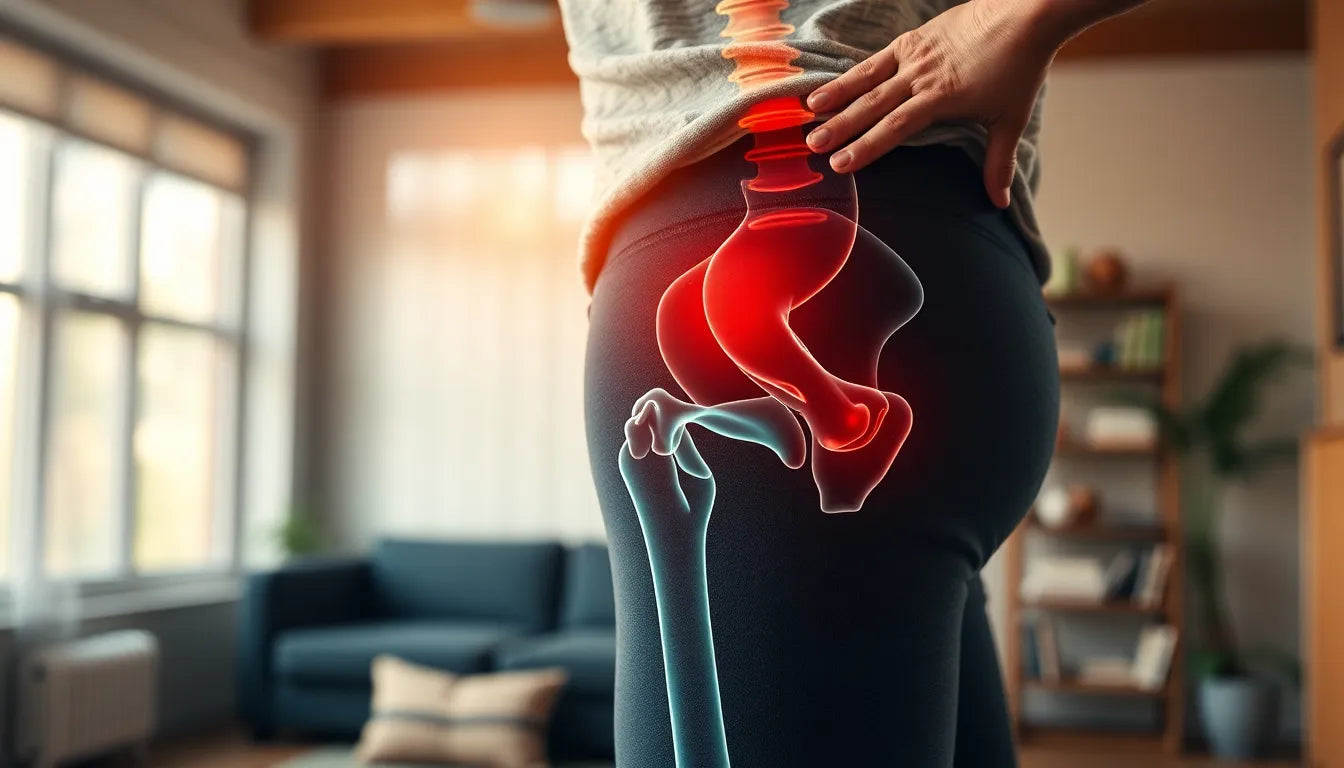Understanding the intricacies of a disk prolapse, or diskusprolaps, is crucial for anyone experiencing back discomfort. A disk prolapse occurs when the soft center of a spinal disk pushes through a crack in the tougher exterior casing. This can affect the spine and surrounding nerves, leading to a range of symptoms. Common signs include persistent back pain, tingling sensations in the limbs, and a noticeable reduction in mobility. These symptoms can significantly impact daily life, making it difficult to perform even simple tasks without discomfort.
Fortunately, there are non-invasive methods to alleviate these symptoms and promote healing. One effective approach is through targeted exercises, known as øvelser, which are designed to support recovery from a disk prolapse. By integrating specific movements into your routine, you can address the root causes of pain and work towards restoring normal function.
The role of exercise in recovery
Exercises for diskusprolaps are not just about relieving pain; they also focus on strengthening the muscles around the affected area. This dual approach helps in both immediate pain management and long-term recovery. By strengthening the core and back muscles, you can provide better support to the spine, reducing the likelihood of future issues.
Consistency and proper technique are key when performing these exercises. Regular practice ensures that the muscles are gradually strengthened and conditioned to support the spine effectively. It's important to perform each exercise with the correct form to avoid further injury and maximize the benefits. This is where professional guidance can be invaluable. A physiotherapist or a trained professional can assess your specific condition and tailor an exercise regimen that meets your individual needs. This personalized approach ensures that you are engaging in movements that are safe and effective for your particular situation.

Lumbar support belt
Provides support and stabilisation for lower back pain, ideal for disk prolapse recovery.
In summary, diskusprolaps øvelser offer a promising path to relief and recovery for those dealing with the challenges of a disk prolapse. By understanding the condition and committing to a structured exercise plan, you can take proactive steps towards reducing pain and enhancing your quality of life. Remember, while exercises are beneficial, they should be part of a comprehensive approach that includes professional consultation to ensure the best outcomes for your health and well-being.
effective diskusprolaps øvelser for relief and recovery
When dealing with a disk prolapse, incorporating specific exercises into your daily routine can be a game-changer. These exercises not only help in alleviating pain but also work towards strengthening the muscles that support your spine. Let's delve into some effective diskusprolaps øvelser that can aid in your recovery journey.
pelvic tilts: strengthening the core
Pelvic tilts are an excellent exercise for targeting core muscles and reducing lower back strain. By engaging your abdominal muscles, you can create a supportive brace for your spine, which is crucial for those dealing with a disk prolapse.
Instructions:
- Lie on your back with your knees bent and feet flat on the floor.
- Tighten your abdominal muscles to flatten your back against the floor.
- Hold this position for a few seconds before releasing.
- Repeat the exercise 10-15 times, gradually increasing the repetitions as your comfort level improves.
knee-to-chest stretch: relieving spinal pressure
The knee-to-chest stretch is designed to relieve pressure on the spine and enhance flexibility, making it a vital part of your exercise regimen. This stretch helps in elongating the spine and can provide immediate relief from tension.
Instructions:
- Lie on your back with your knees bent.
- Bring one knee up to your chest while keeping the other foot flat on the floor.
- Hold the stretch for 15-30 seconds before switching legs.
- Repeat the stretch 2-4 times on each side to maximize its benefits.
walking: gentle movement for healing
Walking is one of the simplest yet most effective exercises for those suffering from a disk prolapse. It promotes circulation, supports healing, and maintains overall fitness without putting undue stress on your back.
Instructions:
- Begin with short walks, gradually increasing the duration as your body allows.
- Maintain an upright posture and steer clear of uneven surfaces to prevent additional strain.
- Aim for 20-30 minutes of walking daily, adjusting the time based on how your body feels.
the importance of professional guidance
While these exercises can significantly aid in managing disk prolapse symptoms, it's vital to seek professional guidance to ensure you're performing them correctly. A physiotherapist can tailor an exercise plan to suit your specific needs, taking into account the severity of your condition and your physical capabilities.
Professional guidance ensures that you are not only performing the exercises safely but also effectively targeting the areas that require the most attention. This personalized approach can accelerate your recovery and prevent further injury.
Incorporating these diskusprolaps øvelser into your routine can offer substantial relief and aid in your recovery journey. Remember, consistency is key, and combining these exercises with professional advice can lead to the best outcomes for your spinal health. By taking proactive steps and committing to these exercises, you can work towards reducing pain and improving your quality of life.
enhancing flexibility and strength with diskusprolaps øvelser
Continuing your journey towards recovery from a disk prolapse, incorporating a variety of exercises into your routine is essential. These exercises not only help in managing pain but also strengthen the muscles that support your spine, promoting long-term healing. Let's explore additional diskusprolaps øvelser that can further aid in your recovery.
cat-cow stretch: enhancing spinal flexibility
The cat-cow stretch is a gentle exercise that improves flexibility and reduces tension in the spine. It is particularly beneficial for those dealing with a disk prolapse as it helps in maintaining spinal mobility.
Instructions:
- Begin on your hands and knees in a tabletop position.
- Inhale deeply as you arch your back, lifting your head and tailbone towards the ceiling (cow position).
- Exhale as you round your spine, tucking your chin to your chest and tailbone under (cat position).
- Repeat the cycle 10-15 times, focusing on smooth and controlled movements.
seated forward bend: stretching the lower back
The seated forward bend is an effective exercise for stretching the lower back and hamstrings. This exercise can help in relieving tension and improving flexibility, which is crucial for those with a disk prolapse.
Instructions:
- Sit on the floor with your legs extended straight in front of you.
- Gently reach forward towards your toes, keeping your back straight to avoid strain.
- Hold the stretch for 15-30 seconds, ensuring you do not overextend.
- Repeat the stretch 2-3 times, focusing on gradual improvement in flexibility.
These exercises, when performed regularly, can significantly contribute to alleviating symptoms associated with a disk prolapse. However, it is crucial to integrate these exercises into a broader recovery strategy that includes professional guidance to ensure safety and effectiveness.

Men's Posture Shirt™ - Black
Patented shirt that activates muscles and relieves back pain to support healthy posture.
frequently asked questions
how often should i perform these exercises?
Aim to incorporate these exercises into your daily routine. Consistency is key, but always listen to your body and adjust the frequency based on how you feel. If any exercise causes discomfort, reduce the frequency or consult a professional.
what should i do if i experience pain during exercises?
If you experience pain during any exercise, stop immediately. It's important to consult a healthcare professional to assess your technique and modify the exercises as needed to prevent further injury.
can these exercises prevent future disk prolapses?
While these exercises can strengthen muscles and improve posture, which may reduce the risk of future issues, it's important to combine them with ergonomic practices and professional advice for optimal results.
are there any exercises to avoid with a disk prolapse?
Yes, it's generally recommended to avoid high-impact activities and exercises that place excessive strain on the lower back. Always seek guidance from a healthcare professional to tailor your exercise routine appropriately.
Incorporating these diskusprolaps øvelser into your daily routine can offer substantial relief and aid in recovery. By committing to these exercises and seeking professional guidance, you can take proactive steps towards improving your spinal health and overall quality of life.
Kilder
- Min Osteopat. ”Øvelser for diskusprolaps i lænden.”
- Gigtforeningen. ”Det kan du selv gøre ved diskusprolaps.”
- Elite Fys. ”Fysioterapi til diskusprolaps i lænden.”
- FysioDanmark. ”Diskusprolaps.”
- YouTube. ”Diskusprolaps øvelser.”
- Fysioterapi Østerbro. ”Diskusprolaps øvelser.”
- Bispebjerg Hospital. ”Øvelser ved diskusprolaps i lænden - del 1.”
- YouTube. ”Diskusprolaps øvelser del 2.”


















